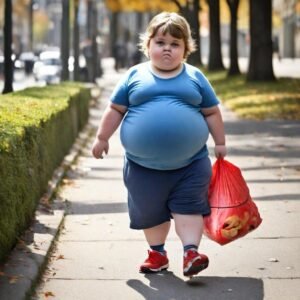Knowing About Childhood Obesity

Obesity in children is a child who has excess body fat is said to
be childhood obese. This condition is usually brought on by a
combination of way of manners, environmental, and genetic factors.
It presents serious health hazards, similar to those related to
cardiovascular illnesses, high blood pressure, and type 2 diabetes.
To stop this epidemic, prevention via good living practices is essential.
The following are some estimated maximum weights based on age ranges:
Babies (0–12 months):
Peak weight gain varies greatly, but most healthy infants will generally
Double by 5-6 months at birth and quadruple by 12 months. As an example:
7-pound A newborn can weigh between 14 and 21 pounds before its first birthday.
Children (ages 1-3 years):
Children tend to acquire weight more slowly than infants. At two years of age,
A youngster may weigh more than four times his or her birth weight. As an example,
A youngster weighing 7 pounds at birth may weigh approximately 28 pounds by the age of two.
Preschoolers (ages 4–5):
Preschoolers grow quickly, but their weight increase is often slower.
to infants and children By the age of 5, a youngster can become internalized.
Contents ↓
- Overview
- Symptoms and Causes
- Diagnosis and Test
- Management and Treatment
- Prevention
Overview of Obesity in Children
Obesity in children is a child who has excess body fat is said to
be childhood obese. This condition is usually brought on by a
combination of behavioural, environmental, and genetic factors.
It presents serious health hazards, such as those related to
is a serious global health issue, characterized by excess body
fat in children and adolescents. Prevention efforts that improve
the risk of health problems, including diabetes and
heart disease, as determined by genetic, environmental, and
behavioural influences, focus on improving nutrition and
promoting physical activity at an early age.
Symptoms and Causes of Obesity in Children

Symptoms:
1. Body weight has increased, and BMI is above age and sex norms.
2. It accumulates excess body fat, especially in the abdomen.
3. Respiratory problems, such as sleep disorder or severe asthma.
4. Fatigue and poor energy, especially during exercise.
5. Psychological effects include low self-esteem, distress, and social isolation.
Causes:
1. Poor Dietary Habits:
Obesity In Children includes consistent eating of high-calorie,
low-nutrient foods and sugary drinks.
2. Sedentary lifestyle:
Includes little physical activity, too much
screen time, and little outside play.
3. Genetic factors:
include a family history of obesity or inherited
genetic predispositions( through family generations)
4. Environmental factors
Influences from the environment:
Add availability to unhealthy
foods, food promotion, and social standing.
5. Parenting
Demonstrate parenting techniques like drawing.
Poor dietary habits and insufficient exercise.
6. Health Status:
Some diseases, for example.
A hormonal imbalance or hypothyroidism may be at fault.
7. Psychological aspects:
Childhood obesity can lead to sadness, trauma, and manners issues.
Problems can exacerbate overeating habit.
8. Not sleeping enough:
Irregular sleep habits can impair hormone function.
When balanced, it influences children’s metabolism and hunger.
9. Chemical Composition:
Certain drugs, such as antidepressants
Corticosteroids may cause weight gain in young persons.
Diagnosis and Test:
1.Physical Exam:
The health care professional determines the child’s weight based on their age and gender.
Using a growth chart, calculate the height and body weight %. Body fat distribution
is also appraised in terms of accompanying health issues.
2. Medical history:
Information on the child’s diet, amount of physical activity,
A family history of obesity, as well as any underlying medical issues that may contribute to weight growth.
3. Blood tests:
Blood tests are performed to examine cholesterol levels and blood sugar (glucose) levels.
Thyroid function and other metabolic indicators to detect any underlying.
Obesity is linked to a variety of medical disorders.
4. Imaging studies:
Some imaging examinations, such as X-rays, ultrasound, or dual-energy
DEXA scans may be indicated for anatomical purposes.
Identify and assess the distribution of sebaceous glands.
5. Psychoanalysis:
related to the psychological evaluation of children entails the determination
of the cognitive processes and emotional status of the juveniles. When finished,
a professional psychologist will produce a full report that can be used by family
members to help them solve the problem of eating disorders or excessive physical inactivity.
6. Evaluation of obesity:
linked issues includes deep understanding of the over weights’ consequences,
for example polycystic ovary syndrome, as well as type 2 diabetes mellitus,
high blood pressure, steatosis of the liver fluids and sexual health problems.
This process of evaluation comprises of physical examinations and removal
of samples to determine the effects on the body’s systems.
7. Watchful monitoring of a child’s weight:
Daily growth and development is require because it promotes prompt recognise
of any signs that may hint at obesity development as the child grows in age.
8. Observing the dietary patterns
Dietary patterns and physical activity levels of the child need to be done on intricate
level, which includes looking at the kinds or types of foods eaten, frequency of eating
Management and Treatment
Lifestyle changes
Dietary changes:
Encourage healthy and balanced meals with healthy portions.
Limit your intake of high-calorie, low-calorie and sugary drinks.
Exercise:
Encourage regular physical activity by limiting structured exercise,
active play, and sedentary ways such as screen time on.
Behaviour Modification:
Implemented strategies to promote unhealthy eating, emotional eating,
and positive way of acting around diet and exercise.
Family interventions:
Engaging the whole family in adopting healthy lifestyle changes to
support a child’s weight management goals. To promote a supportive
home environment that fosters healthy eating and active living.
Nutrition Education:
Let the children and their parents know indeed why this is necessary by
conducting education and mobilization sessions. It consists of gaining
knowledge about what eating healthy involves, understanding food
labels, and making healthy food choices. Include education on meal
planning, suggest cooking basics and eating out strategies in a healthy way.
Exercise program:
Use a delineated regimen intended for a particular age, interest and that
will cause their body to react in several positive ways. Promote people
to join sports, recreation and leisure activities, and other things.
outdoor sports installation to encourage regular physical
exercise.
Behavioural therapy
Cognitive functional therapy (CBT) or counselling may amplify the problem
of negative thinking and can be quite effective in helping solving the problem.
Mental reasons such as binge eating, emotional eating, or body image
problems that are related to habits. The child-friendly interventions can as
well improve the kids on how they can use different techniques that will
help them in overcoming the different obstacles. facilitating the development
of skillsets in stress management and emotional well-being.
Prevention
Promoting healthy eating:
Encourage a balanced diet of whole grains and lean proteins with fruits and vegetables.
Limit your intake of high-calorie, low-calorie foods such as fast food, sugary foods,
and soft drinks. Provide healthy snacks and snacks regularly at home and encourage
shared family meals.
Promoting exercise:
Encourage regular physical activity through active sports, games and leisure activities.
Examples of parents and carers:
Set a good example by adopting a healthy diet and exercising. Involve the
whole family in exercise and eating plans to create an
environment that supports positive behaviours.
Limit access to unhealthy food:
Take junk food and sugary drinks home or limit access. Encourage healthy
food choices like fruits, vegetables, yogurt plus nuts.
Education and Awareness:
Provide education to children and families about the importance of a
healthy diet and regular exercise. Teach children to make informed
food choices, read food labels and understand portion sizes.
CONCLUSION
The conclusion is that the maintenance of children’s places is necessary
to safeguard the well-being of future generations. We can reduce this
public health problem through comprehensive measures including healthy
eating habits, regular exercise and a supportive environment. Collaboration
between families, communities and policy makers is essential to achieve
sustainable change and promote better lives for children around the world.
https://absoluteinformation.com/migraines-home-remedies-without-medication/#more-6562

